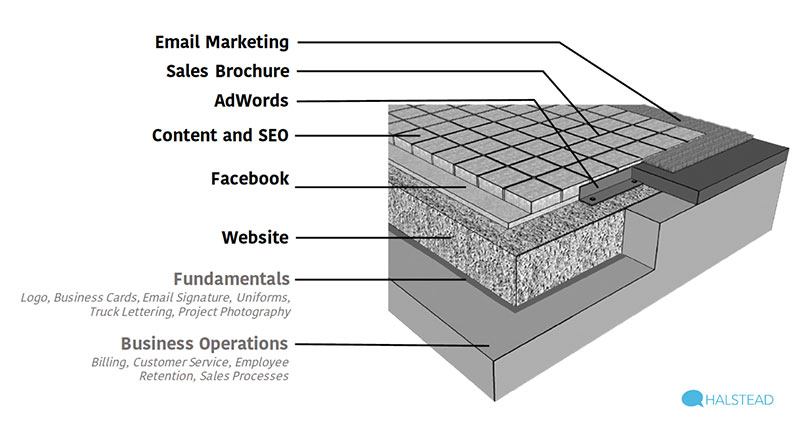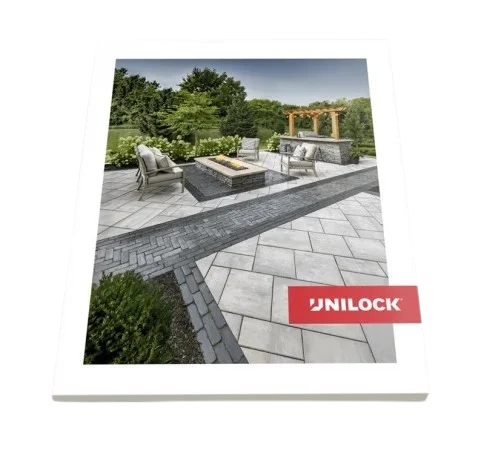Effective Marketing is a system – just like pavers and walls

There is a systematic process to proper paver installation. As a professional landscape contractor, you wouldn’t attempt to install pavers for a patio before completing proper excavation and installing the correct amount of compacted base material. Effective marketing that works in today’s world requires an equally systematic process, with each step influencing the following steps. Following this systematic approach will result in a quality “installation” of proper marketing techniques for your landscape design/build company.
Web Design
Similar to how your crews wouldn’t be effective on a job site without their demo saws, your website is a marketing tool that is critical to success. In fact, think of the website as the base material – it provides an essential foundation that makes the rest of the installation possible. A poorly designed website will not convert visitors into customers, in turn causing you to waste a significant portion of your marketing budget without getting the desired results.
But what qualifies as good web design? How do you know if yours is good? Here are a few of the most important aspects of a successful website that will give your business an essential advantage:
Usability
A website that is difficult to figure out how to use will drive potential customers away. After arriving at a company’s website via a referral site such as Facebook, 50% of people will orient themselves using the navigation bar. It is a necessity to have a simple, easy-to-use navigation system that guides potential customers toward making contact. Inviting calls-to-action is an essential usability feature, as well, directing users to relevant information for their specific needs.
Imagery
The design-build industry is one almost entirely built upon aesthetics. A landscaping website that does not reflect the beauty of the company’s work risks losing the opportunity to reach its full potential. Having photographic documentation of your installation process and, even more importantly, finished projects, is what will sell the quality and value of your work.
Mobile
Mobile responsive websites are no longer a fun extra feature – they are a necessity. Over 52% of website visits are now coming from mobile devices and tablets. Your website needs to cater to what is now a majority of potential customers searching for contractors like you on their smartphones. Not only does a non-mobile responsive website hurt your ability to land new projects, but it also hurts your ability to close referrals. According to CMS Report, 57% of users say they won’t recommend a business that has a poorly designed mobile site.

Photography
It is no secret that the outdoor living industry relies heavily on impactful visuals. Homeowners need to feel emotionally connected to a potential purchase, and for hardscapers, that emotional connection is delivered through amazing project photography. Critical to every single aspect of your marketing system, photography is part of a stable foundation, just like the geotextile layer of a paver installation.
But how do you make sure you get the photos you need for effective marketing? Here are three popular approaches that deliver results.
- Hire it out: if you can afford to make this investment, hire a professional photographer to come to 2-3 of your best projects. The right professional will ensure they get the proper angles to accent the design. On average, the cost for a full day photo shoot will range somewhere between $750- $2,000. This price does not include any staging efforts, so that responsibility will fall on you. Take along some pillows, wine glasses, and throw blankets – they will make all the difference in the world.
- Invest in a jobsite camera: If having a photographer come to each jobsite seems like too much effort, consider investing in a professional grade camera specifically for project use. It will be with the crew on all projects, making it easier to remember to take photos once the project is finished. It may require some personal training to learn solid techniques for capturing the design, but the sales results will speak for themselves.
- Start somewhere: If hiring a professional photographer or investing in a high quality camera do not seem feasible at the moment, you still have to start somewhere. Skipping project photos is not an option. Use a smartphone to take some shots of the install process and some of the finished project. Even if they are not professional quality, these photos can still be used to bolster your website, social media, and blog content.
Facebook and Instagram
Social media is no longer exclusively the millennials’ game. Both Facebook and Instagram hold tremendous value for contractors if deployed properly. Think of social media as the bedding sand layer of your install as it forms the foundation for your company’s content and ongoing story.
Why Facebook?
Facebook is the leading social media platform for the design-build industry’s key age demographics: 79% of people between the ages of 30-49 use Facebook, as do 61% of those aged 50-64, according to the Pew Research Center. Engaging on Facebook is a great way to generate an emotional connection with users. With Facebook’s highly-targeted ad specifications, it is possible to put your business in front of the eyes that count. For example, if you have noticed that a substantial percentage of your customers are retired, Facebook can target specifically to retired people in your service area. Virtually any demographic, interests, or qualities of your ideal customer audience can be targeted through Facebook ads.
Why Instagram?
While it may feel like the demographic of Instagram users is too young to attract as customers, this is simply not true anymore. In fact, 1/3 of Instagram users are between 30-49 years old, which might be right within your desired audience. On top of that, over 70% of businesses are posting on Instagram as of 2017. This means that Instagram’s impact for businesses is spreading, and now is the perfect time use this platform, before it becomes overwhelmed with self-promoting businesses. Instagram has a particular advantage for the hardscape industry, as this platform is all about the visuals. By using the high quality photos mentioned earlier in this article, your Instagram posts are bound to be eye-catching and valuable to prospective customers. And since 65% of top-performing Instagram posts feature products, hardscape contractors can seek maximum advantage with images of properly staged and well-lit patios and walkways. Instagram’s interest algorithm will take quality posts and place them in front of the eyes that will be most interested in your company’s work.
Content and SEO
While the old customer may have been less educated about the industry, having conducted little to no research in the hiring process, that is not the case with today’s customer. The current crop of customers are educated on the outdoor living industry and have conducted thorough research before even landing on your website, let alone engaging in contact. During this rigorous research, what drives people to one website above the rest? Search Engine Optimization (SEO). This is the key to making sure that when people search on Google for hardscape contractors in their area, your website comes up at the top of organic search results. Think of your content and SEO like the concrete pavers themselves – the forward-facing piece of the puzzle that customers should engage with on a regular basis.
One of the most effective ways to provide SEO for a landscaping website is to create written and visual content on the site – in other words, blog. According to Hubspot, companies that blog on their website generate 126% more leads than companies that don’t blog. Blog content, with targetable keywords and enticing imagery, is part of what sells your company to prospective customers. Looking at website content is simply a part of the research process now. In fact, about 47% of consumers will see up to five pieces of content from a company before talking to a member of the sales team. Take all of your company’s knowledge as professionals in the industry, and turn it into a showcase for potential customers by creating a thriving, interesting blog feed.
PRO TIP: Circulate Blog Content. Once a blog has been posted to a website, that is not the only place it can live and drive traffic. Post it on Instagram, create a Facebook ad from it, put it in an email newsletter, etc. Good blog content can be used across all platforms to drive traffic to your website and create new leads for your business.
AdWords
Many believe that the best way to use AdWords is to continuously throw more and more money at Google. This is a common and costly misconception. It takes more than dollars and cents to attract users to click on an ad and stay on your website once they do. It takes thoughtfully constructed content, situated within a nice-looking landing page, and a comprehensive execution that satisfies exactly what the customer is looking for. As content acts as the pavers in this marketing system, consider AdWords to be the edge restraint – supporting, not replacing, your content and SEO efforts. Following these simplified AdWords steps will help you land a better ad rank and a well-performing page:
- Create a better landing page: Rather than having prospective customers land on your home page, where their precise needs may be buried in a navigation tab that they will have to search for, use a specific landing page. This page is designed to cater to the specific search request, so the user does not have to search around for the answer to their problem. The landing page should have a simple layout with plenty of information and images about the keyword, signaling to the searcher that they have found the right place. This page will improve your “quality score” which Google uses to help determine the ad’s rank.
- Bid: AdWords is an auction and the ad rank does depend on how much is spent. Set your CPC (cost per click) bid in AdWords. Then, when the ad starts generating clicks, Google will not charge more than the maximum CPC bid for those clicks.
- Evaluate the numbers: AdWords allows users to access the analytics of their ads, including performance numbers like click-through rate (CTR), amount of time spent on pages, and which buttons and photos are getting clicked. Pay attention to these analytics, and adapt the landing page and ad text to meet the needs of potential customers.
Sales Brochures (Point of Sale Tools)
The sales brochure is the joint sand of an effective marketing system: while it is a small part of the process towards the end of the install, it is critical to the system’s long-term performance. Even though digital marketing is becoming increasingly prevalent, traditional marketing collateral is still extremely valuable at the point of sale. Expensive home improvement purchases evoke emotional responses for potential clients. Elegant, beautiful point of sale tools, like sales brochures, are a simple way to harness that emotion and create a connection with a customer. Even if you’re a fantastic salesperson, decisions about large outdoor living projects will almost always be made long after you are gone. Using your top-notch photography only, develop a brochure that resonates with homeowners after you leave, while they are discussing the different contractors that came over to estimate their project. Essentially, you should match the quality of the marketing piece you leave behind with the dollar value of what you are selling. Much like when you go to a new truck showroom and receive a beautiful, magazine-style brochure, your potential customers will expect something substantial and beautiful just the same.







